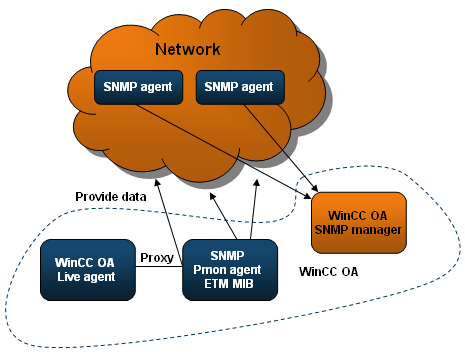SNMP
SNMP (Simple Network Management Protocol) is a protocol for monitoring network devices (servers, workstations, routers, switches and hubs etc.) and their functions. It allows you to administer your network.
SNMP is platform independent, can be extended easily and only requires minimum system resources. It can also help you to find out and solve network problems.
SNMP differentiates between two types of management units: managers and agents. The agents provide the information and the managers query it and are able to write this information. Thus, the manager sends a request to the agent and the agent sends a response to the manager. The information is queried via the SNMP protocol. In order to avoid unnecessary network load, the SNMP data is exchanged via UDP.
The agents also inform the managers about unexpected or interesting events via so called "traps". The data provided by the agents is defined in so called MIB's (Management Information Base). MIB is a file where data is defined in a tree structure.
Within WinCC OA SNMP differentiates between the SNMP Pmon agent, the SNMP live agent (API manager) and the WinCC OA SNMP manager.
SNMP Pmon agent
The SNMP Pmon agent serves WinCC OA project monitoring data (manager index, manager names, manager states,...) from the manager table over SNMP. This can be queried by an SNMP manager. It is also possible to get information about changes of the manager states via SNMP traps. Thereby WinCC OA can be monitored via external network tools.
The Pmon agent also acts as proxy for the live agent.
SNMP live agent
The SNMP live agent serves values of data points of a project over SNMP (data point names, data point original values, original time, ...). Via SNMP it is also possible to write a data point element in the project. This can be used, for example, for triggering a CTRL script. The result of this script is also available over SNMP. With the live agent it is also possible to send an SNMP trap with an arbitrary text.
To provide data for external SNMP managers, the SNMP Pmon agent acts as proxy for the SNMP live agent.
Further information about the OIDs of the WinCC OA MIB can be found under: MIB - WinCC OA MIB
SNMP manager
The WinCC OA SNMP manager (WinCC OA driver) collects the data from external (or WinCC OA internal) SNMP agents, which has to be configured in the SNMP configuration panels by the user. The collected data is mapped to data point element values in the WinCC OA database. For data points, which represent the collected data, an SNMP peripheral address needs to be configured.
As the data can also be collected from external SNMP agents, for example, an alarm can be shown in WinCC OA when a network element fails. In this event an agent of an external network element makes the data available for the WinCC OA SNMP manager.
The SNMP manager can also write values to SNMP agents, provided that write-access is given. In addition it is possible to map the contents of SNMP traps, which are received by the SNMP manager, to WinCC OA data point elements via peripheral addresses.
WinCC OA supports different versions of the SNMP protocols:
- The WinCC OA SNMP manager supports SNMP v1, v2 and v3.
- The WinCC OA SNMP agent (Pmon, live agent) supports v1 and v2.




